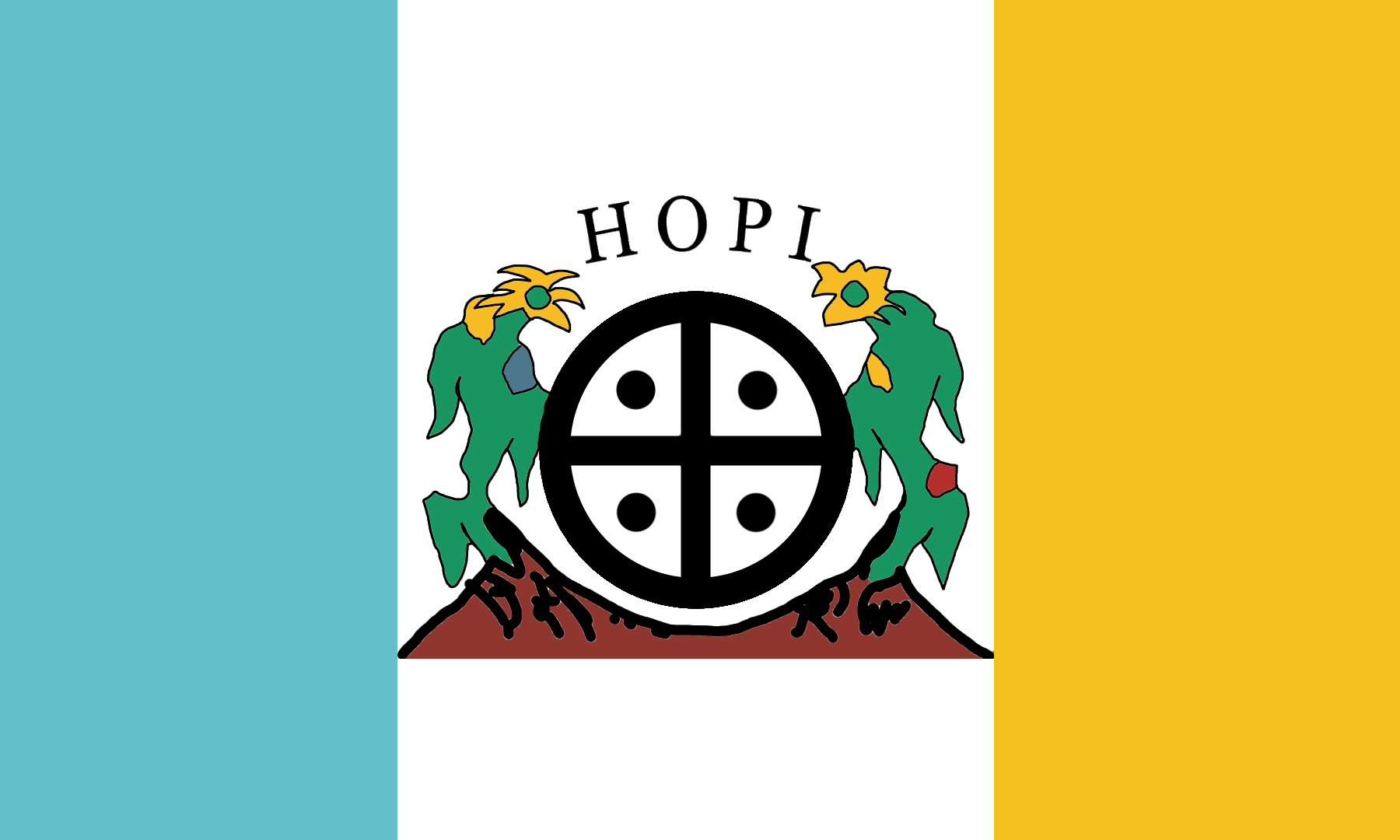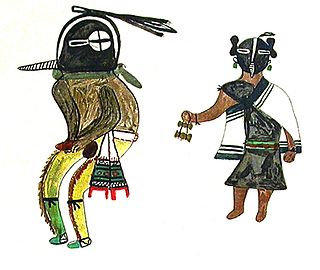
Kokopelli is a fertility deity, usually depicted as a humpbacked flute player, who has been venerated by some Native American cultures in the Southwestern United States. Like most fertility deities, Kokopelli presides over both childbirth and agriculture. He is also a trickster god and represents the spirit of music.
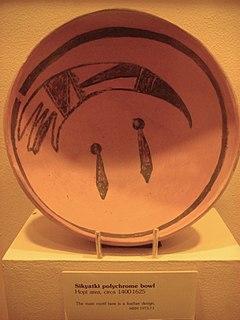
The Hopi maintain a complex religious and mythological tradition stretching back over centuries. However, it is difficult to definitively state what all Hopis as a group believe. Like the oral traditions of many other societies, Hopi mythology is not always told consistently and each Hopi mesa, or even each village, may have its own version of a particular story. But, "in essence the variants of the Hopi myth bear marked similarity to one another." It is also not clear that those stories which are told to non-Hopis, such as anthropologists and ethnographers, represent genuine Hopi beliefs or are merely stories told to the curious while keeping safe the Hopi's more sacred doctrines. As folklorist Harold Courlander states, "there is a Hopi reticence about discussing matters that could be considered ritual secrets or religion-oriented traditions." In addition, the Hopis have always been willing to assimilate foreign ideas into their cosmology if they are proven effective for such practical necessities as bringing rain. The Hopi had at least some contact with Europeans as early as the 16th century, and some believe that European Christian traditions may have entered Hopi cosmology at some point. Indeed, Spanish missions were built in several Hopi villages starting in 1629 and were in operation until the Pueblo Revolt of 1680. However, after the revolt, it was the Hopi alone of all the Pueblo tribes who kept the Spanish out of their villages permanently, and regular contact with whites did not begin again until nearly two centuries later. The Hopi mesas have therefore been seen as "relatively unacculturated" at least through the early 20th century, and it may be posited that the European influence on the core themes of Hopi mythology was slight.
In Hopi mythology, Aholi is a kachina, a spirit, also called a kachina. He is a friend of Eototo and is very handsome; he wears a colorful cloak with a picture of Muyingwa and is the patron kachina of the Pikya clan. Aholi once allowed his throat to be slit so that Eototo could escape. They eventually met again. Aholi,a chief Kachina on Third Mesa appears with Eototo. Both are principal Kachinas appearing in the Powamu and other sacred rituals.
Chakwaina is a kachina which appears in Hopi, Zuni, and Keresan ceremonies, but does not appear in Tewa ceremonies. Although imagery of the kachina is varied, it is usually depicted as an ogre, with ferocious teeth and a black goatee and black mask with yellow eyes. Its spread throughout Pueblo culture is often associated with the Asa clan.

Jesse Walter Fewkes was an American anthropologist, archaeologist, writer and naturalist.
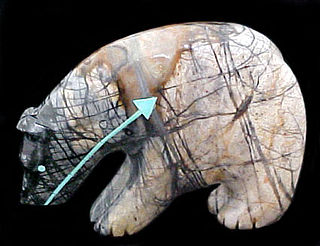
Zuni fetishes are small carvings made from various materials by the Zuni people. These carvings have traditionally served a ceremonial purpose for their creators and depict animals and icons integral to their culture. As a form of contemporary Native American art, they are sold with secular intentions to collectors worldwide.
Angak is a Hopi kachina spirit, represented by spirit dancers and a corresponding kachina doll figure, known to non-hopis as Longhair.
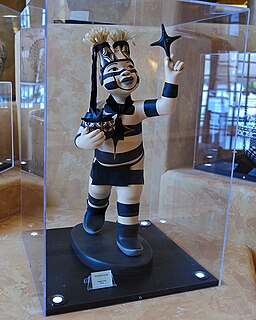
The Pueblo clowns are jesters or tricksters in the Kachina religion. It is a generic term, as there are a number of these figures in the ritual practice of the Pueblo people. Each has a unique role; belonging to separate Kivas and each has a name that differs from one mesa or pueblo to another.

Hopi katsina figures, also known as kachina dolls, are figures carved, typically from cottonwood root, by Hopi people to instruct young girls and new brides about katsinas or katsinam, the immortal beings that bring rain, control other aspects of the natural world and society, and act as messengers between humans and the spirit world.
Ahöla, also known as Ahul, is a spirit being, a kachina, embodied by a man, in Hopi religion.
In Hopi mythology, Ahöl Mana is a Kachina Mana, a maiden spirit, also called a kachina. She is represented as a standard Kachin Mana; it is because she arrives with Ahöla that she is called Ahöl Mana. During the Powamu ceremony, she goes with Ahöla as he visits various kivas and ceremonial houses. On these visits Ahöl Mana carries a tray with various kinds of seeds.
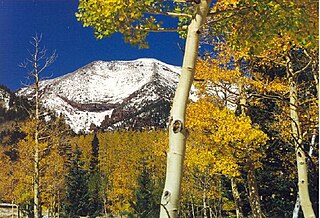
Kachina Peaks Wilderness is a 18,616-acre (75 km2) wilderness area about 6 miles (10 km) north of Flagstaff within the Coconino National Forest in the U.S. state of Arizona.
In Zuni and Hopi mythology Patung is a kachina fetish that relates to healing and agriculture. The Hopi belief is that Patung showed the Puebloan peoples how to plant corn, then vanished.
In Hopi and Zuni dance rituals, Hú, also known as Huhuwa and Tithu, is the Kachina of the hummingbird.
Eototo is a Wuya, one of the major kachina deities of the Hopi people and the personification of nature. He is the protagonist of the Powamu ritual.

Art of the American Southwest is the visual arts of the Southwestern United States. This region encompasses Arizona, New Mexico, and parts of California, Colorado, Nevada, Texas, and Utah. These arts include architecture, ceramics, drawing, filmmaking, painting, photography, sculpture, printmaking, and other media, ranging from the ancient past to the contemporary arts of the present day.
In Frank Waters's writings on Hopi mythology, the Blue Star Kachina or Saquasohuh, is a kachina or spirit, that will signify the coming of the beginning of the new world by appearing in the form of a blue star. The Blue Star Kachina is said to be the ninth and final sign before the "Day of Purification", described as a catastrophe or a "world engulfing cataclysm" that will lead to the purification of planet Earth.. Author Jason Colavito investigated this prophecy and found no reference to it before the late twentieth century.

Neil Randall David, Sr. Is a Hopi-Tewa American Indian artist and katsina carver. He learned the basics of carving from his grandfather Victor (Kawayo) Charlie.
Tsaveyo is the Giant Ogre kachina, one of the Hopi spirit beings. There are numerous Hopi stories and legends about him. These date from the time of the Hopi migrations.


